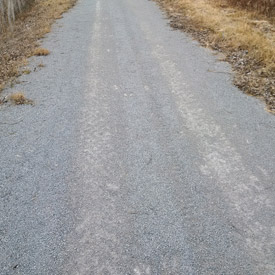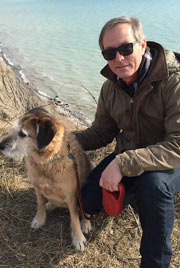A race for survival, and a photo finish
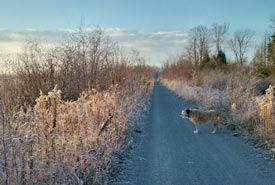
Ella enjoying the sunrise along the Beaver River trail (Photo by Mark Stabb/NCC staff)
Nature lovers are spoiled by the phenomenal wildlife footage circulating on various media these days. But you don’t have to be a cinematographer to capture real-life wildlife “foot”-age of your own. This little photo essay shows that nature, wild in tooth and claw, awaits your discovery right around the corner.
The Beaver River Trail, northeast of Uxbridge, Ontario, is a “rail trail” that slices through the 6,180-acre (2,500-hectare) Beaver River Wetland. The wetland and river eventually drain into Lake Simcoe. Part of the Trans-Canada Trail, the pathway forms the linear nucleus of a successful land securement partnership between NCC and the Lake Simcoe Region Conservation Authority.
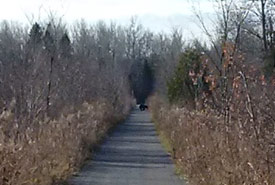
The yonder black bear probably watched and waited as Ella and I passed before crossing the trail behind us on a November walk (Photo by Mark Stabb/NCC staff)
This also happens to be one of my favourite dog-walking spots.
The trail provides an upland passage along and across the marsh and swamp habitats of the wetland. It has become an elevated travel corridor, and occasional viewing spot, for mammals such as beaver, muskrat, mink, fisher and even black bear. Coyote and white-tailed deer are also common in the area.
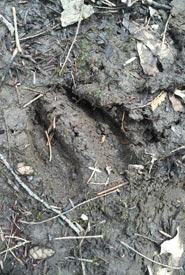
Walking track of white-tailed deer (Photo by Caroline Schultz)
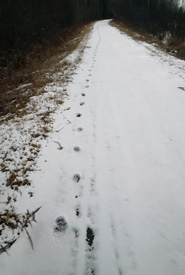
Coyote tracks along Beaver River Trail (Photo by Mark Stabb/NCC staff)
I am used to seeing deer tracks on the trail, but this one (below) stopped me in my own tracks. A casually walking deer makes that classic upside-down heart-type track with the two main toes of its feet close together. It is rare for the rear “dewclaws” to show up in tracks from a deer walking on gravel. This set was quite different. (Compare the tracks yourself.)
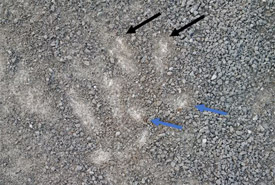
Deer tracks with dewclaws imprints (Photo by Mark Stabb/NCC staff)
These are tracks of a deer leaping or in full flight. Note the wide spread of the front toes (black arrows) and the imprint of the dewclaws (blue arrows), which are providing additional support or power. The distance between the toes and dewclaws indicate these are the hind feet. The tracks below are the front feet, with dewclaws closer to the toes. They also show the deer running at top speed.
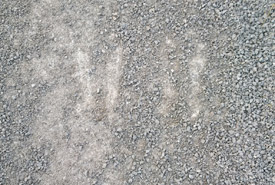
Tracks of a deer’s front feet, with dewclaws closer to the toes (Photo by Mark Stabb/NCC staff)
It wasn’t long before I found the reason for the running. It was a sprint for survival. The tracks below are of a coyote, also running full out. The tracks show the toes also spread wide and having kicked up the dry gravel, which at a walking gait would remain mostly in place.
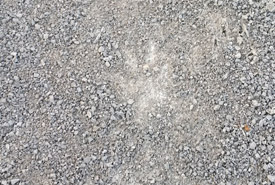
Tracks of a coyote running full out (Photo by Mark Stabb/NCC staff)
Notice the claw marks of another paw dug into the hard-packed ground to the right.
A segment of the 100-metre dash between predator and prey can be seen to the left. (Look carefully and zoom in to follow the different sets of tracks).
At the top of the picture you will see where the deer changed course and diverted to the field to the north.
The next two photos show the location of this split-second evasive maneuver. Perhaps the deer reacted to the coyote gaining ground on the straight-away and quickly made a break for an opening in the bushes.
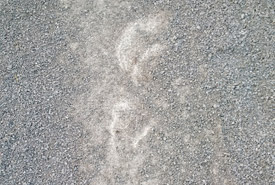
Deer making a hard right and leaving the trail (Photo by Mark Stabb/NCC staff)
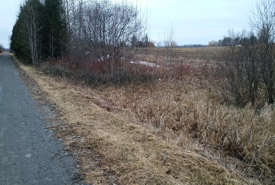
The tracks of both animals disappeared into this farm field through a gap in the shrubbery (Photo by Mark Stabb/NCC staff)
I don’t know what happened next. It is most likely the deer outran the coyote and survived the day. Only a handful of such chases ever end in a take-down. But the coyote does win sometimes, and when it does it may leave evidence along the trail as well.
I took the photo below the same day further down the trail.
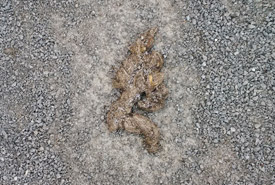
Fresh coyote scat chock full of deer hair (Photo by Mark Stabb/NCC staff)
So what do you think of this fresh coyote scat chock-full of deer hair? A photo-finish (for the deer), perhaps?
Nature will always reveal a secret or two, every time you look.

